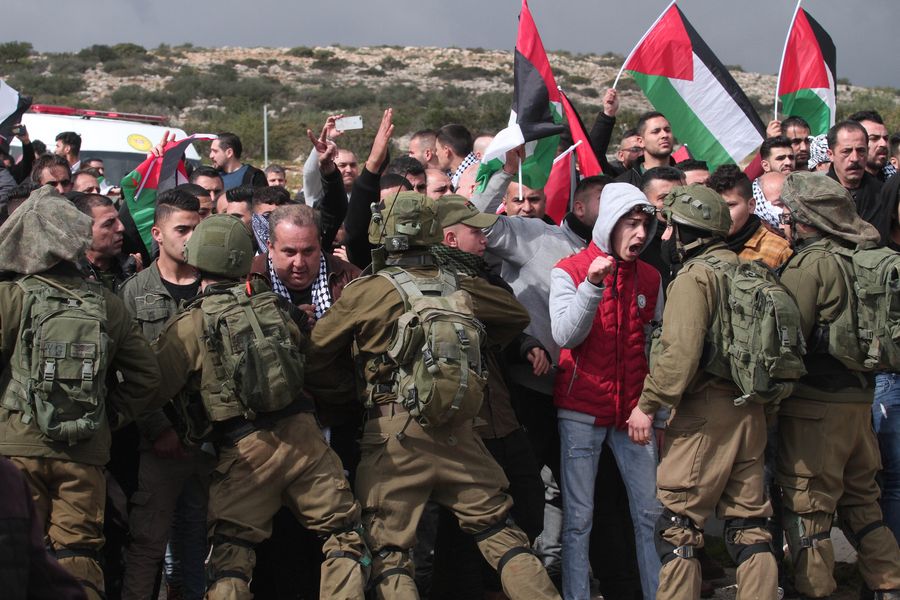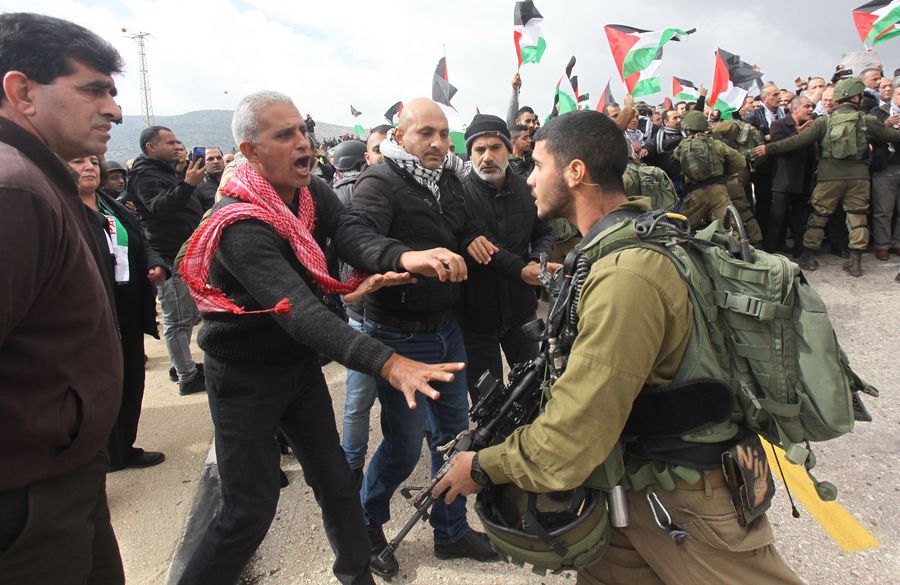 Palestinian shout slogans during a protest in the southern Gaza Strip town of Khan Younis, Jan. 29, 2020. (Xinhua/Yasser Qudih)
Palestinian shout slogans during a protest in the southern Gaza Strip town of Khan Younis, Jan. 29, 2020. (Xinhua/Yasser Qudih)
Palestinians continue protests in the West Bank and the Gaza Strip, against the U.S. Middle East peace plan.
RAMALLAH/GAZA, Jan. 30 (Xinhua) -- For the second day in a row, the Palestinians in the West Bank and the Gaza Strip joined on Wednesday the mass protests against the announced U.S. Middle East peace plan, also known as the Deal of the Century.
Officials and eyewitnesses said clashes broke out between hundreds of Palestinian demonstrators and Israeli soldiers in several West Bank towns, mainly in the areas of the Jordan Valley.
 Palestinian protesters clash with Israeli soldiers at an Israeli checkpoint, east of the West Bank city of Tubas, Jan. 29, 2020. (Xinhua/Nidal Eshtayeh)
Palestinian protesters clash with Israeli soldiers at an Israeli checkpoint, east of the West Bank city of Tubas, Jan. 29, 2020. (Xinhua/Nidal Eshtayeh)
The U.S. deal "is serving Israel's interests and ruins their dreams of having an independent Palestinian state on all the territories occupied by Israel in 1967, with East Jerusalem as its capital," they noted.
Dozens of Palestinian demonstrators and foreign peace activists rallied in the Jordan Valley area before clashes broke out with Israeli soldiers when they were banned from reaching the territory, the witnesses said.
Jihad Abu el-Assal, Palestinian governor of the Jordan Valley area, told reporters that the rally was organized to express clear rejection of Israel's decision to annex the territory.
"The lands of the Jordan Valley are owned by its citizens and no one has the right to annex it," he said.
"The territory is vital and strategic for the Palestinians, and U.S. President Donald Trump doesn't have any right to give it to Israel," he added.
 Palestinian protesters clash with Israeli soldiers at an Israeli checkpoint, east of the West Bank city of Tubas, Jan. 29, 2020. (Xinhua/Nidal Eshtayeh)
Palestinian protesters clash with Israeli soldiers at an Israeli checkpoint, east of the West Bank city of Tubas, Jan. 29, 2020. (Xinhua/Nidal Eshtayeh)
The Jordan Valley, which represents 30 percent of the West Bank, was occupied by Israel in the 1967 Middle East war. The territory is important for the Palestinian economy, agriculture, and tourism.
Clashes also broke out in the West Bank cities of Bethlehem, al-Beereh, Tulkarem, and Hebron, where demonstrators burned tires and threw stones at the Israeli soldiers who fired tear gas and rubber bullets to disperse them.
The Palestinian Red Crescent Society reported that at least 41 Palestinian demonstrators were injured: four were shot by Israeli soldiers' rubber gunshots while others suffered suffocation after inhaling tear gas.
Meanwhile, a general strike dominated the Hamas-ruled Gaza Strip where all stores closed, as hundreds of young men and schoolchildren took to streets in protest against the U.S. peace plan.
 Palestinians burn tires during a protest against the U.S. Middle East peace plan in the southern Gaza Strip city of Rafah, on Jan. 28, 2020. (Xinhua/Khaled Omar)
Palestinians burn tires during a protest against the U.S. Middle East peace plan in the southern Gaza Strip city of Rafah, on Jan. 28, 2020. (Xinhua/Khaled Omar)
The office of the Hamas chief Ismail Haniyeh said in a press statement that Haniyeh, who is currently in Qatar, welcomed Palestinian President Mahmoud Abbas' decision to send a delegation from the West Bank to Gaza next week.
"Sending a Fatah delegation to the Gaza Strip to discuss unity after the U.S. Deal of the Century was declared is a positive step that prepares for a new stage in the Palestinian dialogue for unity," the statement said.
The internal Palestinian division between Fatah and Hamas began after the latter forcibly seized control of the Gaza Strip and routed the security forces of Abbas in the summer of 2007. ■



